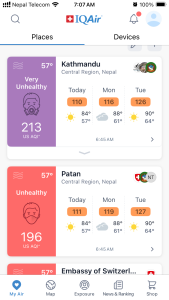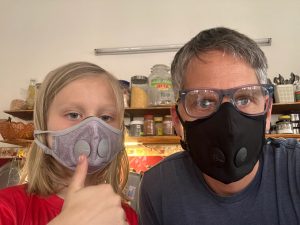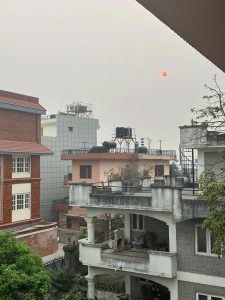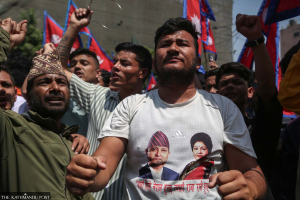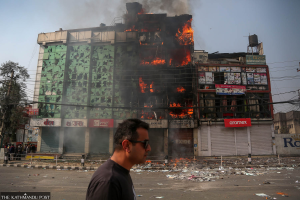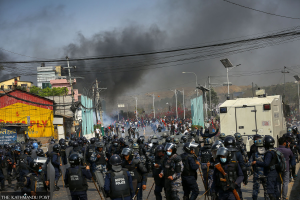Mitch Rhodes
Just to confirm the above, I have never been a smoker, even casually, but the internet tells me that I’ve been doing the same thing just by breathing air in the Kathmandu Valley the past few weeks. A 2023 article from The Hill, linked here: https://tinyurl.com/bdcujssc, explains the equivalent number of cigarettes you would have smoked in 24 hours of breathing polluted air, depending on the exact level of pollution, measured by the AQI, or Air Quality Index. So the air in the valley was consistently reaching 200 or even 300 last week. Those in the Great Lakes region will remember this level of dirty air in the Summer of 2023 due to the Canadian wildfires. If you breathe that air for 24 hours, it’s the equivalent of smoking half a pack a day. In case you didn’t know, there are 20 cigarettes in a standard pack (I had to look that up.)
Thankfully, we are only exposed to such bad air when we are outside and not wearing our pollution masks. At home, we keep windows closed and our air purifiers running. This is the same for the boys at school. However, we don’t have air purifiers at the office, and I’m not sure how much polluted air leaks in through the windows there. Luckily, it’s not so hot yet, so keeping windows closed isn’t a major hardship. So with our outside hours limited, even on the really polluted days, we are probably only smoking the equivalent of a few cigarettes a day. Maybe between one and two. Still, who wants to be smoking at all?
Below, you can see what my AQI app shows me. Purple is very bad. Red is not great, but at least it’s not as bad as purple. By the way, AQI is very localized and there are about six or seven air monitors in the valley. Sometimes the air close to our house is different from downtown Kathmandu. But generally, the past few weeks, we were in purple for much of the time. In the middle photo, Auggie and I model our air pollution masks, which we wear when we are outside, meaning about 15 to 30 minutes a day, usually in our commute on the bike. The last picture is to show you how malevolent and ominous the red sun looks in our polluted sky. My phone’s camera doesn’t really do it justice.
For comparison, here is the chart of AQI icons. Green is very clean, of course. Brown is the worst. Some recent days here were brown, and Kathmandu ranked as the most polluted city in the world for that day.
Practically, for us here, this has meant that on those days, the kids aren’t allowed to have outside recess, and the swimming lessons– part of the P.E. curriculum– that Auggie was looking forward to a few weeks ago were cancelled because of the air quality. The pool where they have their lessons is outside. (Auggie wants me to mention that when they finally went to the pool, when the air had cleaned up a bit, it was too cold, so the PE teacher only let them put their feet in the water and “practice kicking.” Can’t win ’em all, I guess.) The dirty air also meant that Ira’s overnight camping trip with the school’s Duke of Edinburgh (kind of like Scouts) group was postponed. They will try again in early May. Auggie and I were also planning to join a day-long hike for the British School students and families, but it was also cancelled.
The levels of pollution in the Kathmandu Valley have been a problem for decades. In fact, I’ve already bored you with this topic just last fall. What seems different this time is the level of concern by the school (cancelling trips, keeping kids inside for recess, etc.) and the amount of news articles, letters to the editor in the newspaper, etc. The spring is often a time for dirty air here, as the cleansing rains (more on that later) are too infrequent to keep the air clean, and the monsoon is still months away (usually starting mid-June). Yet this year has seen a hotter and drier spring and consequently more forest fires than most years (climate change, anyone?) This has all contributed to the problem.
So it was a great relief when the rains started this past Thursday around 4 am. I woke up to the gentle sounds, and soon it was a deluge with thunder and lightning. Auggie and Ira also said they woke up to the rain. I don’t think anyone was annoyed that night. I didn’t mention Lora waking up to the rain because she’s been in Malaysia for a week-long work-related conference. She’ll report on that for the next blog. Also, I was quite jealous when she reported the air quality in Malaysia being 14 (!!), which, of course, is green on the AQI scale. When she left us 9 days ago, her flight out of Kathmandu was delayed by two hours due to poor visibility caused by the pollution. She gets home late tonight. Everyone here is very eager for her return!
And lucky for her, we have much cleaner air here as well. The rain has brought our AQI down to the yellow range. This is quite clean for Kathmandu! We even opened the windows today. It’s continued to rain a bit each day, but almost certainly this won’t last very long, and we might see the AQI numbers creep back up before long, at least until the real monsoon arrives in June, as I mentioned above.
The other main topic of this post is the recent unrest here in Kathmandu as a result of demonstrations turning into riots by people who want to see a return of Nepal’s king. This is the king whose reign was brought to an end by parliament only about 17 years ago, after 240 years of Nepal’s Hindu Shah dynasty. The former king, who was not exiled or killed after being dethroned, is getting a lot of support from people for various reasons. But the main reason I’ve seen in news reports is that many are fed up with corruption and ineffective leadership in the current Nepali government.
In fact, ever since we arrived here over a year ago, a common theme we hear from friends and strangers alike, told to us in English or Nepali, is that all the leaders are corrupt and should be held to account for bribery, graft, nepotism, you name it; that this corruption in the ruling class is the reason that Nepal is still not a fully developed country, and why people still have to rely on family members working abroad and sending home remittances to make it financially. People are starting to sour on those promises that were made by the politicians who overthrew the king and established the republic. Things have been building recently, but came to a head on March 28th at a pro-monarchy demonstration in Kathmandu. Pictures below are from the Kathmandu Post article the next day.
The protest quickly turned violent and led to a number of hospitalizations and two deaths. One journalist was killed in a building that the protesters set on fire, and one pro-monarchist demonstrator was killed when Nepali police used live rounds on the crowd. There was also looting, rock throwing at the police, and eventually, a curfew was called on that section of the city. Read more in this AP article if you wish: https://tinyurl.com/bdh3zz4e
Interestingly, a number of people attended a counter-protest in a different part of the city at the same time. They had 35,000 people compared to the rioters, who only numbered about 5,000. Yet their pro-democracy demonstration, which unfolded peacefully, got little attention. The numbers would seem to indicate that there’s not much appetite for a return of the king. In fact, the pro-monarchists have their own party with representation in parliament, although they are currently the fifth smallest party in terms of seats held.
To be clear, the riots on March 28th were bad, but they were isolated and did not spread. Everyone we knew had avoided that part of town anyway, and in fact, Lora and I were spending a night away at a resort hotel north of the city to celebrate our 11th anniversary. We didn’t know much about the protests until reading the paper the next day.
The following picture is proof of the relatively clean air in our neighbourhood today! You will notice we live close to the Swiss Embassy, where there is an AQI monitor hooked into the system.


